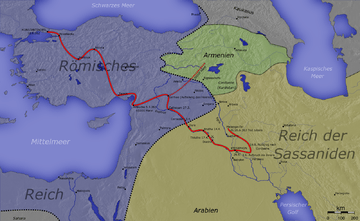Battle of Samarra
| Battle of Samarra | |||||||
|---|---|---|---|---|---|---|---|
| Part of the Julian's Persian War | |||||||
 A map of the campaign up to the battle of Samarra | |||||||
| |||||||
| Belligerents | |||||||
| Sasanian Empire | Eastern Roman Empire | ||||||
| Commanders and leaders | |||||||
|
Shapur II Ardashir II[2] | Julian the Apostate (DOW) | ||||||
| Strength | |||||||
| Unknown; a force comparable to the Roman army | 35,000[3] | ||||||
| Casualties and losses | |||||||
| Unknown | Unknown | ||||||
The Battle of Samarra took place in June 363,[1] after the invasion of Sassanid Persia by the Roman Emperor Julian. A major skirmish, the fighting was indecisive but Julian was mortally wounded in the battle. The Romans, stranded deep in Persian territory and suffering from a lack of supplies, were forced to accept terms for peace.
Context
Julian invaded Sassanian Empire with a force of 65,000[3] men, hoping to win a major victory against Persians in the east and replace Shah Shapur II with his brother Ormisdas.[4] Julian made two blundering mistakes at the very onset of the invasion. He split his force into two, one under General Procopius numbering 30,000 men,[5] which went to northern Mesopotamia, and one numbering 35,000 men[3] under his own leadership. His second mistake was not defeating the main Sassanid army before attacking the capital, which would eventually lead to expedition's failure in 363. Julian at first won a tactical victory outside Ctesiphon, but could not take the city. Even worse, Procopius failed to join him with his army, for unknown reasons.
David S. Potter[6] suggests that Julian's main faults was that he made a very risky campaign and that he didn't bring adequate siege train. Therefore, he had to retreat after realizing that Ctesiphon was too strongly defended to be taken by assault while his army was running out of supplies. However, the Sassanid army, under Shapur, implemented a scorched earth policy while harassing Romans all their way back to Roman Mesopotamia. Julian, realizing that his army could not be resupplied or reinforced, tried to force a set piece battle with his enemy, but could not.
So decision was taken to retreat through the district of Corduene to the north, where there was hope to find adequate supplies.[7] After a few days of advancing through the enemy country, despite defeating Persian skirmishes and inflicting them heavy losses in the Battle of Maranga,[8] the demoralized[9] army was essentially depleted of provisions and tired of the continuous fighting.
The battle
After three quiet days, the Roman army was attacked during its cautious advance in square formations. The battle at Samarra was a Persian skirmish,[10] first against the rear guard of the Roman column. Then they fell on the center and the left wing of the Romans. According to Ammianus Marcellinus narrative,[11] Julian hastened to rally his forces against the Persians, without wearing his armor. He managed to raise their morale and reverse the possibility of collapsing but his personal guard was dispersed during the fighting and Julian was fatally hit on his back by a spear. The spear was most probably thrown by a Saracen (Lakhmid) auxiliary in Persian service, as his doctor Oribasius concluded.[6][12] After treatment by the doctors, he returned to the battlefield. The battle continued indecisively[10] until the darkness of the night put an end to the fighting. According to other views, the Roman army was victorious [13] or was defeated by the Persian forces.[1] Julian died from his wound, in his tent, a few hours later.
Aftermath
The Roman army's general staff proclaimed Jovian, the commander of Julian's guard, as his successor. He led his army to the east bank of Tigris, under continuous harassing from the Persians, and suffered heavy losses.[14] After failing to cross the Tigris, Jovian clearly saw that the situation was desperate. Thus he was forced to accept humiliating terms from Shapur, in order to save his army and himself from complete destruction.[14] The treaty with Shapur included surrendering Eastern Mesopotamia, Georgia and Armenia, as well as fifteen fortresses, including the strategic cities of Nisibis and Singara, without their inhabitants.[15] This severely hampered the empire's defensive system in the east and gave the Persians favorable conditions in their subsequent confrontations with the Romans.
Citations
- 1 2 3 Shapur II (iranicaonline)
- ↑ http://www.iranicaonline.org/articles/ardasir-ii-sasanian-king-of-kings-a
- 1 2 3 Farrokh 2005, p.47
- ↑ Libanius, Epistulae, 1402.2
- ↑ Browning 2004, p.196
- 1 2 Potter 2004, p.518
- ↑ Ammianus Marcellinus, Res Gestae, 24.8.5
- ↑ Ammianus Marcellinus, Res Gestae, 25.1.19
- ↑ Ammianus Marcellinus, Res Gestae, 25.1.7
- 1 2 Browning 2004, p.213
- ↑ Ammianus Marcellinus, Res Gestae, 25.3.2-12
- ↑ Libanius, Orations, 24.6
- ↑ Dignas, Beate & Winter, Engelbert. "Rome and Persia in Late Antiquity: Neighbours and Rivals". p. 34-37, Cambridge University Press
- 1 2 Browning 2004, p.216
- ↑ Ammianus Marcellinus, Res Gestae, 25.7.9
References
- Ammianus Marcellinus' works in English at the Tertullian Project with introduction on the manuscripts
- Browning, Robert, The Emperor Julian, University of California Press, 1976, ISBN 0-520-03731-6
- Kaveh Farrokh, Sassanian Elite Cavalry AD 224-642, Osprey Publishing, 2005
- David S. Potter, The Roman Empire at Bay AD180-395, Routledge, 2004